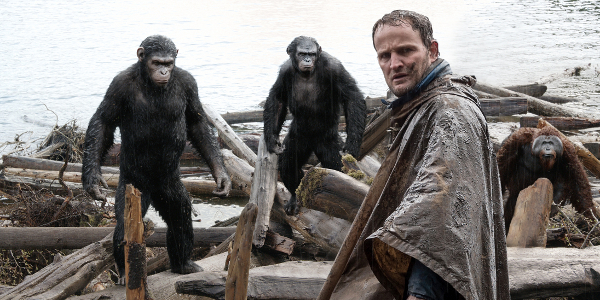Dawn Of The Planet Of The Apes (2014)
July 23, 2014 1 Comment
 Ten winters have passed since Simian flu devastated the human race and left a new generation of uber-apes to inherit the Earth. They are ruled by Caeser (Andy Serkis), the chimpanzee indirectly responsible for both man’s demise and the ape uprising, who leads alongside Koba (Toby Kebbell), his trusted second in command. When a small number of humans are found to have survived, however, the relationship between Caeser and Koba begins to fray; mindful of the friendship he once shared with a human Caeser pushes for peace, while Koba insists that they eradicate their one-time abusers once and for all. There is disharmony in the human camp too, with Malcolm (Jason Clarke) wanting to work alongside the apes in order the restore power to San Francisco and Dreyfus (Gary Oldman) determined to declare all-out war on Muir Woods.
Ten winters have passed since Simian flu devastated the human race and left a new generation of uber-apes to inherit the Earth. They are ruled by Caeser (Andy Serkis), the chimpanzee indirectly responsible for both man’s demise and the ape uprising, who leads alongside Koba (Toby Kebbell), his trusted second in command. When a small number of humans are found to have survived, however, the relationship between Caeser and Koba begins to fray; mindful of the friendship he once shared with a human Caeser pushes for peace, while Koba insists that they eradicate their one-time abusers once and for all. There is disharmony in the human camp too, with Malcolm (Jason Clarke) wanting to work alongside the apes in order the restore power to San Francisco and Dreyfus (Gary Oldman) determined to declare all-out war on Muir Woods.
It speaks volumes about the legacy of Tim Burton’s ill-fated reboot that even after the unexpected success of Richard Wyatt’s Rise of the Planet of the Apes audiences are still skeptical of the franchise’s modern-day reimagining. This year’s sequel, despite all evidence to the contrary, was widely expected to undo Wyatt’s good work and reinstate the series’ standing as a laughing stock. In reality, however, Dawn of the Planet of the Apes is perhaps even better than its predecessor; the title may be just as cumbersome, but everything else is sleeker and even more satisfying than before.
Following a brief newsreel hinting at the scale and severity of the initial ALZ-113 outbreak, Dawn of the Planet of the Apes eschews humanity in favour of ape-kind, checking in with Caeser and the family he has raised over the last decade. The original film was remarkable for a number of reasons, the most obvious being its portrayal of Caeser himself. Serkis is once again exceptional, combining well-observed behavioural ticks and intuitive sign language to give Caeser unmistakable personality. He is this time joined by a number of other talented motion-capture artists too; Kebbell and Greer are terrific as Caeser’s advisor and mate, but it’s newcomer Nick Thurston who ultimately impresses most as his wary son, Blue Eyes.
Despite bravely shifting the focus to Caeser, the emotional centre of the previous film was arguably John Lithgow’s Charles, the Alzheimer’s-stricken father of Caeser’s human guardian. Here, however, the human characters barely feature (though Keri Russell still manages to distinguish herself as a grieving mother), and on this occasion it’s the relationship between Caeser and his son that grounds the film emotionally. The corrupted youth trope is hardly a new one, but the unique setting and singular characters nevertheless lend it an element of novelty, if not originality. Their relationship is as nuanced, touching and sympathetic as any you are likely to see this year.
This is far from a subdued melodrama, however, and Matt Reeves — who directed Cloverfield prior to the rather less successful Let Me In— certainly knows how to stage an effective set piece. This being a prequel we already know roughly what is going to happen, but Reeves still manages to invoke a sense of suspense by keeping the stakes personal and the characters interesting. After a moment of light relief in which Malcolm et al manage to generate enough electricity to power a gas station radio, war returns to San Francisco as the horse-riding, gun-totting apes lead a charge on the virus-resistant human resistance. Chaos erupts as battles break out — human vs. human, human vs. ape, ape vs. ape — and each conflict is as compelling as the one before.
Given the law of diminishing returns, whereupon sequels — let alone sequels of prequels of reboots — regularly fail to live up to their predecessors, it’s all the more remarkable that Dawn of the Planet of the Apes is as good as it is. With its state-of-the-art special effects, quasi-satirical subtext and measured character study, this is undoubtedly one of the strongest competitors for best blockbuster of the year.


















